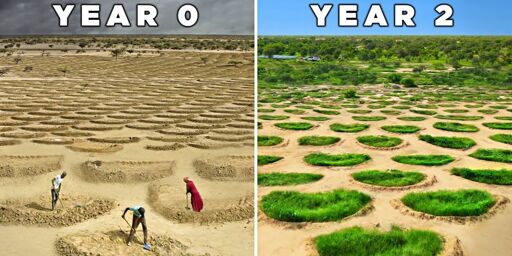Just a few years ago, the Sahel region at the northern edge of Senegal was a “barren wasteland” where nothing had grown for 40 years. But the United Nations World Food Programme (WFP) and local villagers teamed up to regreen the area, bringing back agriculture, improving the economy of the people who live there, and preventing the climate migration that desertification ultimately leads to.
I’ve seen a few posts on this and it’s always exciting to see this mix of cultural wisdom and environmentalism.
But I’m always left wondering why we aren’t supporting these communities with some heavy equipment to do this. From the article it takes a person an entire day to dig one of these moons. Surely some construction equipment could work order(s?) of magnitude faster. I can’t help the hinting feeling that we’re offloading all of the burdens of addressing global climate change onto the communities that are already paying the steepest price.
Is it the climate? How remote the locations are? Challenges with sourcing parts? Hope someone can clarify why heavy equipment would be prohibitive.
These are always only pilot projects with limited funding. And who do you think is more likely to maintain this infrastructure and proudly tell their neighbours about them so that they can replicate it? Surely not the person that is annoyed that some rich guy from the capital with a digger came and did all the work and took all the money that they would have happily earned. These largely subsistence communities are cash starved and projects like that are a welcome opportunity to earn some money on the side.
The difference in efficiency is so high, you could run through with the backhoe and then give locals the money anyway.
Community buy-in is more important than efficiency in projects like this.
“The process started with the community-based participatory planning,” WFP program policy officer Bakalilou Diaby shares in the video. “By the end of this process, it was agreed that one of the major action is the land reclamation or land recovery project.”
At first, it took some time to convince the community that the regreening of the degraded landscape was even possible, but after learning about how to improve the land, “the people believe and they are convinced, and they are also committed,” says Diaby.
Sure, these projects could be done more efficiently by one construction company with heavy machinery, but that takes dollars these dirt poor areas don’t have (and I think Trump’s bullshit arbitrary defunding of USAID is an object lesson for developing countries not to rely on foreign charity for anything important, among many, many other reasons why foreign charity is bad for development). So local people need to know how to do it with local resources in order to expand the projects to new areas.
Just as important, local communities need to support and maintain these projects in the long run, and sweat equity is a great way to build commitment.
Something along the lines of “hiring heavy equipment, then buying a ticket to the gym, everytime you need this done because you never learned anything else”. My neighbours tell me I need heavy equipment to fell my forest, absolutely not, I’ll go on foot, respect and fell every single tree I plan to fell, leave no tracks, become stronger and wiser, all for free.
Heavy equipment is not cheap, too, especially if you need an operator with skill comparable with attention to small details that manual laborers have naturally. And it does not spread virally like skills. And it burns carbon and leaves tracks. It has its uses at scale, but not in pilots. Same thing everywhere: I have a pick-and-place robot to assemble my electronics, not even turning it on before I have at least 100-ish boards to assemble; it’s not expensive, it’s easier than manual labor - but you’ve got to know the system you build before giving it away to a machine, or you’ll have a long and expensive debug session ahead of you, even if you are certain know everything about it, which is totally not the case here.
Oh no… tracks. In the barren wasteland. Where the whole point is creating divots for water.
Surely some construction equipment could work order(s?) of magnitude faster.
You have to supply the support network for the equipment. For a lot of less developed areas, it isn’t worth it to supply a tractor which will become a statue.
And part of the project is to employ local labor
Digger plus a tank of petrol a day is absolutely feasible no matter where you are in the world. There is no “less developed” area that they don’t have this. Everywhere has cars, everywhere has petrol powered boats and generators.
The cost of a tank of fuel for a digger in this area exceeds the average national monthly salary of Senegal. And I imagine this area has way below the average salaries.
I can’t say for certain, but I’ll take a stab at an answer that isn’t just “to cut costs obviously lmao”.
Part of the purpose of these ecological initiatives is to figure out ways to do things at scale without the need for industrial waste/pollution.
Second, it is best practice in most any industry to create and optimize the process by hand BEFORE figuring out how to optimize it with heavy industry. If you begin the design under the handicap of a machine, then your entire design is founded on that crutch. You can always incorporate machinery, but it’s often more difficult to remove it from any process once it’s been integrated.
I know absolutely nothing about living in the desert but I bet driving heavy equipment on sand (hard-packed or not) is a risky business.
Driving heavy equipment on sand is not that risky. We’re talking a single digger here, not a 1000t mobile crane.
But I’m always left wondering why we aren’t supporting these communities with some heavy equipment to do this.
From the different videos I’ve seen on this it’s also because they are both teaching people to do this themselves and pay them for doing it at the same time. Thus supporting the local economy and sort of kick-starting it. Getting one outsider to do it with a tractor doesn’t create local attachment to this.
Why can’t the locals be trained to operate and maintain the tractor?
Probably also because there’s more than one community they need to support and there’s only one person who would receive additional income, instead of most in the community. And by teaching all to do it manually and showing the impact. (Which is making more land suitable for sustenance farming)
And getting local support is always vital to create long lasting success. Using a tractor would probably not guarantee this.
Then again you might get better answers if you look up some of these videos by organisations covering this. They usually have titles like “turning the dessert green again”
I don’t really see it as a fixed amount of work that needs to be distributed among all the people. Getting more half moons dug in a shorter amount of time will reclaim a lot more farmland, and will have labor opportunities in actually working the land.
Digging out the half moon, one per person per day, is only the start. These communities are trying to actually grow crops, too. So it seems that if you have a pool of labor available, the upper limit is going to be how much agricultural land area can be managed by that labor pool. At that point digging more half moon patches isn’t going to create any more opportunities (unless we’re talking about improving the agricultural productivity per worker, and should probably talk about farming equipment too). If the income is to come from the crops they produce, shouldn’t increasing the output of crops be economically good for that community?
It seems that using equipment would transform a larger quantity of land, which is good for the environment in general. Then, the economic impact would still be distributed among the entire workforce, able to work that land and do the actual agriculture.
What am I missing?
When looking up more details it seems that it’s actually not possible to make them mechanically. It’s considered one of the disadvantages despite their simple and cheap implementation.
Edit: I think you’re also applying a western image of what farmland is to this situation. I don’t think I can do it justice so I highly recommend you look up some of these videos to get better picture, it’s quite interesting and at least some glimmer of hope to see that some land can be reclaimed from erosion and desertification.
Availability of fuel and spare parts. Using any machinery in desert areas increases their demand for repair. Because sand is nasty.
The biggest factor is that the cost of labour is extremely low. If the machinery costs €200 in fuel a day, you could instead pay 40 people in these rural and impoverished areas.
Thanks for sharing, Steve. This is such a cool fucking post.






